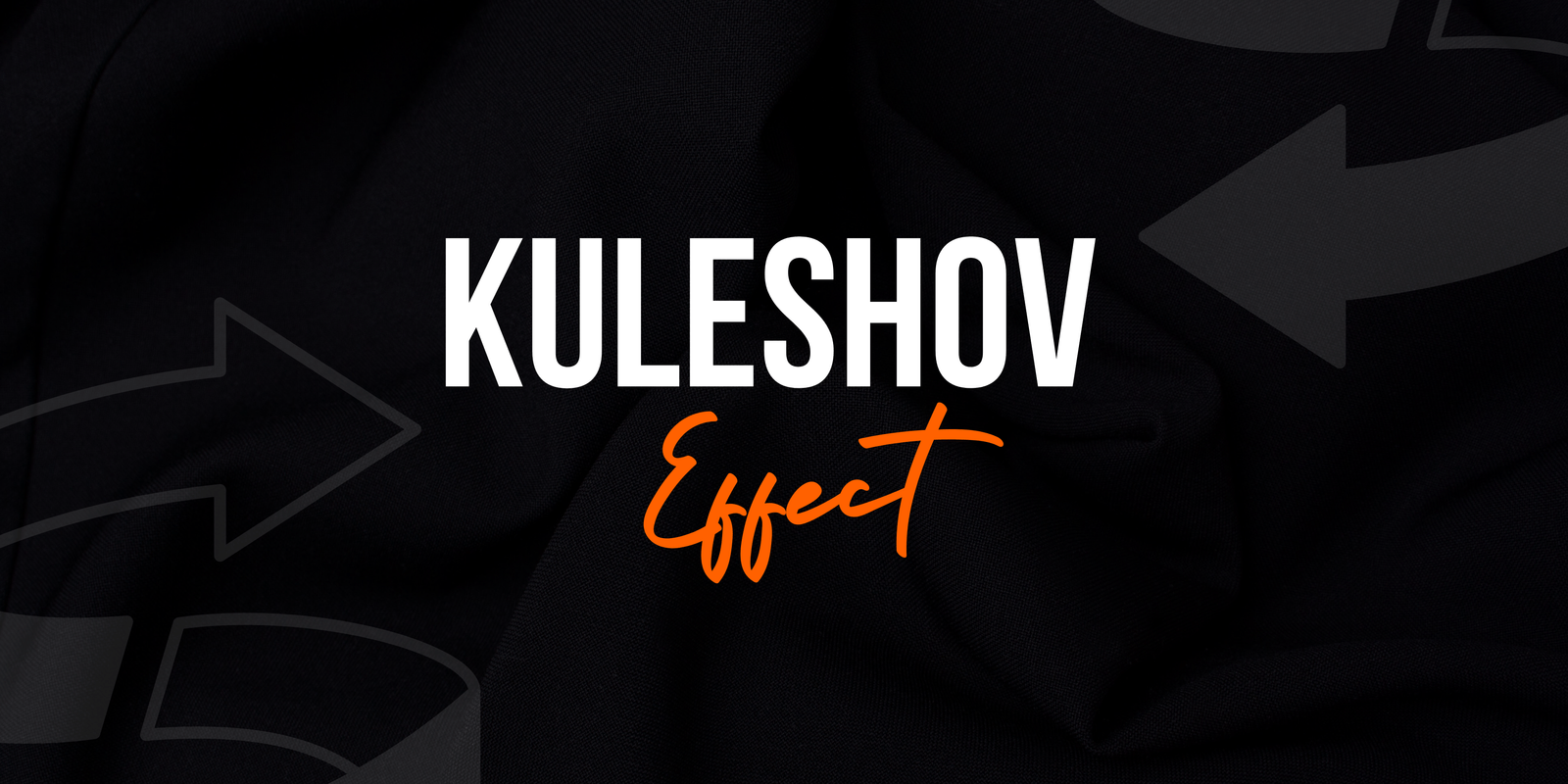I’ve been interested in video editing for as long as I can remember. The superpower of communicating how it feels with pictures and beauty inspires me. This is what I’ve always wanted to do and have done for many years.
But not the part where, 24/7, something needs to be fixed with one program or another. When you’re almost done with your editing, suddenly, the program crashes, or maybe you lose your files, and many more issues arise. I have always wanted the best editing software with no issues like those.

Honestly, Premiere Pro drained my spirit for video editing. It just couldn’t handle how I wanted to create. I would get interrupted to solve problems with the program, and this took so much time away from my opportunity for creative flow. I don’t like doing stuff under pressure; I want it to be fun.
I’m willing to bet that 99% of every other video editor I’ve spoken with who uses the program runs into similar issues. I started believing that this is the reality of every video editor—no one can resolve the editor’s problems.
Table of Contents
Well, Blackmagic came up with the magic. They resolved almost everything for video editors. DaVinci Resolve 19 changed my life. As a video editor, I can focus on my creative workflow rather than troubleshooting, which I’ve always wanted.
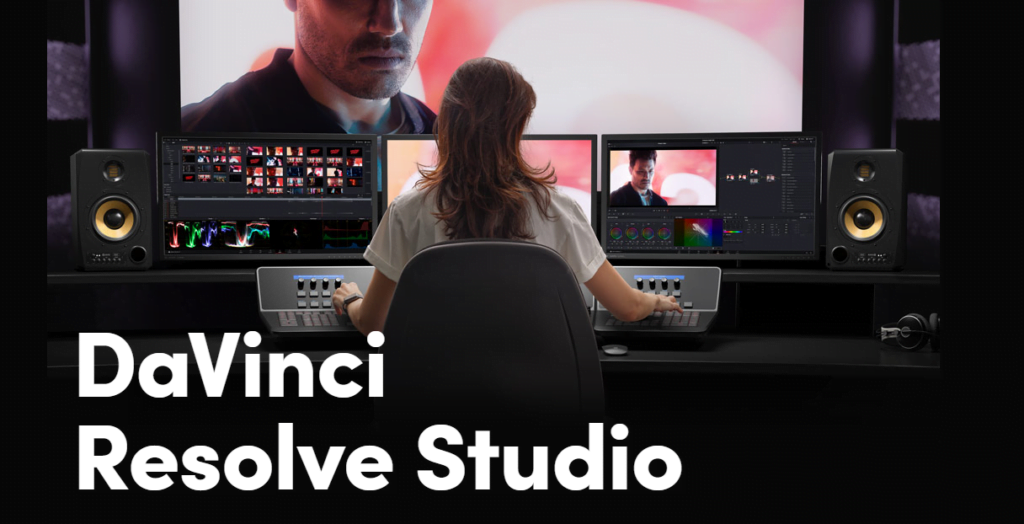
But I hear this a lot—many editors feel that DaVinci is too advanced or complex for them. Even though DaVinci offers many fancy features, this doesn’t mean you must use all or any of them. Over time, it grows with your needs. You can begin as an amateur, but as you transition to professional, there are higher-end tools that you may integrate into your workflow.
DaVinci Resolve is the best bang for your buck in editing, whether you’re making a vlog or a feature film.
But enough of that. In this blog, I will describe my experience moving to DaVinci and why I believe it is arguably the best editing software.
DaVinci Resolve Price
Price is the most important factor. DaVinci Resolve is the least expensive software out there. It also has a free version that lacks features but can still process things. An interesting fact: DaVinci Resolve has a paid Studio version for $295, comparable to Final Cut. However, if you are an editor using Final Cut, you must cough up another $50 for Apple’s Compressor. Even the fully paid version of DaVinci is cheaper than Final Cut.
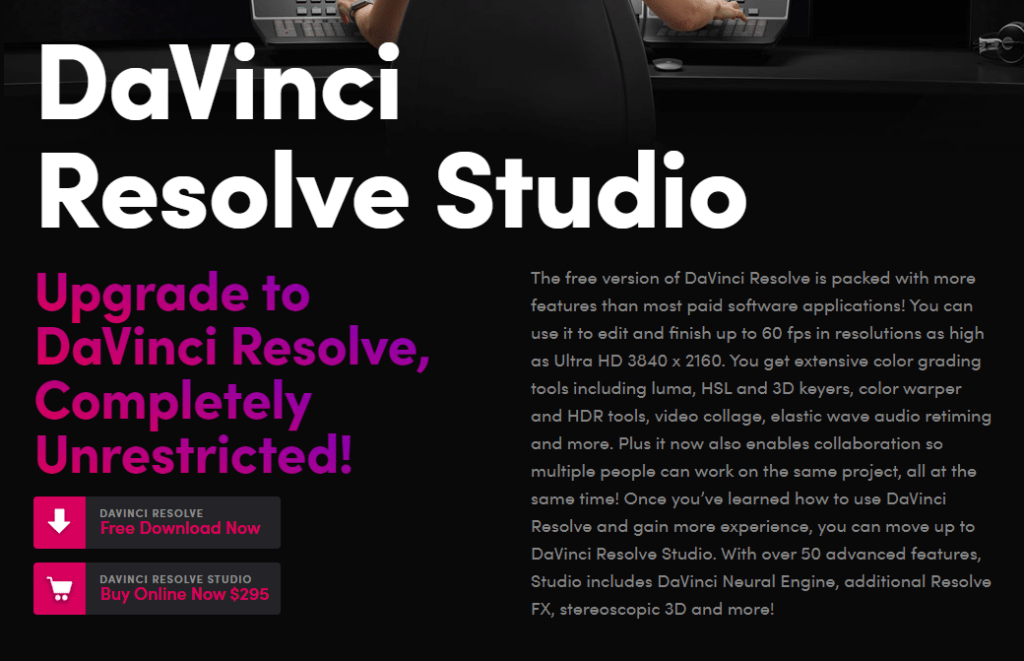
Blackmagic also gives you DaVinci Resolve Studio free with one of their cameras. This is amazing.

Where Adobe offers a subscription plan, you can buy just one or all of the software based on their subscription plan. You need to pay for your software almost every month, whereas, with DaVinci, you purchase it once to enjoy it for your whole life.
These days, 30% of feature films use DaVinci. Its full version is now the cheapest out there. And truly, it almost makes no sense to me to choose other programs instead of DaVinci.
Speed And Reliability
DaVinci is a speed demon that is super fast and super reliable. I could import my 4K, 120 fps footage and immediately scrub tasks on my timeline with no need for proxies and absolutely zero dropped frames—a problem in Premiere Pro that plagued me constantly. This almost equals what you get in Final Cut if you’ve used it instead of DaVinci.
This type of speedup in DaVinci itself is one of those things that, once you experience it, you cannot go back.
Premiere was notorious for crashing several times per major project, but that is a thing of the past with DaVinci. Thanks to live saves and backups, I no longer even click save. I can close out this program now, confident that none of my progress will be lost.
Well, it would be smart to do this if only for reliability. It will make the editing experience easier, enabling us to enjoy working on such projects with far better results.
Interface
Da Vinci made a great interface for video editors. They wisely divided the program into seven spaces so we could be hyper-focused and not just throw everything anywhere.

Starting from the bottom, we have a Media tab where you can import and arrange all your media. The next tab is the Cut Tab, where you can cut your selects. This tab is a simplified version of the Edit tab.
Then comes the Edit Tab. This is where we create the primary edit, and it’s probably similar to the interface of Final Cut/Premiere Pro. We can do speed ramping, cropping, keyframing, and other editing tasks here.
On keyframing, remember how you had to manually zoom in and out super slow in all the videos in Premiere? DaVinci has a feature called Dynamic Zoom, where you can add zooms and pans to your clips in less than ten seconds. Traditionally, this is done by placing the green square where you want a clip to begin and slapping down a red box for its end. It’s easy as pie! No more hand-keyframing your video clips.
The Fusion Tab comes after the Edit Tab. This is another built-in application with many more complicated visual effects and transitions you can add before exporting.
The Color Tab is the color grading area. After that, the Fairlight Tab comes. This is a built-in DAW (Digital Audio Workstation) where we can sound design for our video. I like this section. Then comes the Delivery Tab. Here, you can export your videos to show your work to the world.
Export Individual Clips
This is a great example of how much Blackmagic thought firsthand about the editor’s problems. Almost every editor needs to export individual files to clients or another editor. I also use this most of the time in my editing.
This is a super simple but super helpful feature that stands out from DaVinci and other software.
Team Collaboration
We are in an era where most of us work remotely; collaboration is everything.
Even for this, Blackmagic has done something remarkable. Cloud-based collaboration tools allow you and your team to work on the same project simultaneously, even if you are miles away from each other. So you can have your editor, colorist, and sound designer in different places but still work as if sitting beside each other. It’s a virtual studio.

Additionally, integration with other software, such as Fairlight for audio post-production and Fusion for VFX, allows you to diversify the possibilities of your creative tools while remaining in an ecosystem. They are meant to make your life easier and allow for more creativity.
Shortcuts
As editors, we first think about our shortcuts when switching software. Having new shortcuts makes it feel like we’re learning everything from scratch.
But Blackmagic did great in this. They allow all popular software to be in their shortcut menu, and you can also upload your own customized shortcuts to DaVinci Resolve.
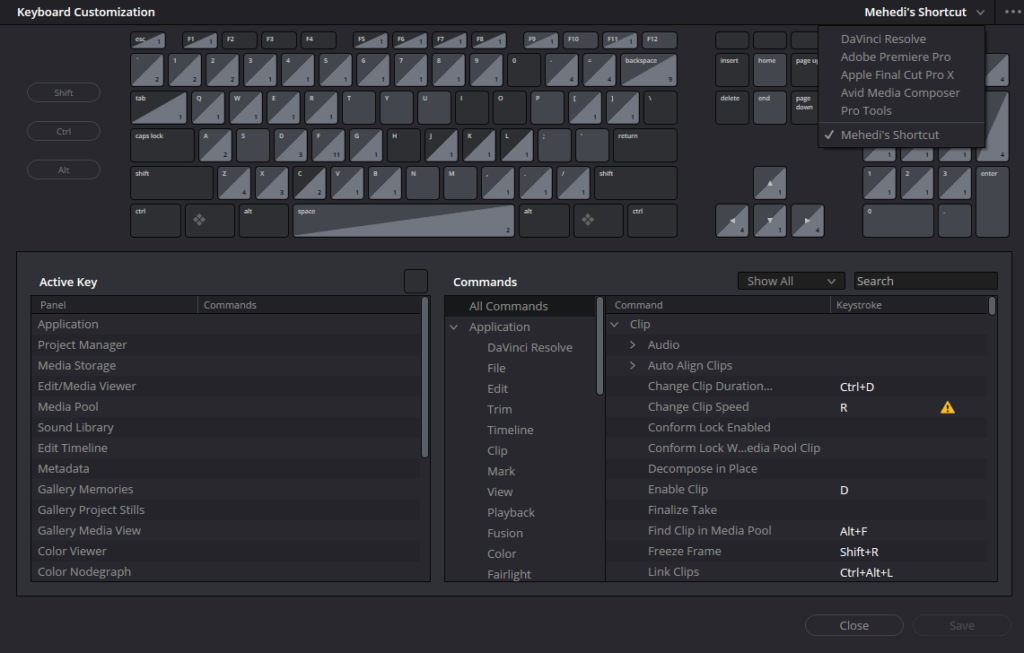
Color
DaVinci Resolve is popular for color grading, and I truly understand why. They made the color editing process easy and fun, and you can easily incorporate your ideas into your project.
However, in other software, you may know what to do with the project and which elements to use, but you can’t bring them to your work for various reasons. But in DaVinci, this is super fun and easy.

I already posted the overall interface of the Color Tab. I recommend you read that. It will help you in your color grading process.
Fusion
Fusion is like a built-in After Effects. If you come from Adobe, you may understand what I am saying. In Adobe, if you want to do advanced work, like advanced effects or transitions in your project, you need to switch from Premiere Pro to After Effects. But DaVinci Resolve resolves the problem. You don’t need to switch software to another for advanced things.
This boosts your workflow. If you want to add advanced effects or distortion, switch from the Edit tab to the Fusion tab. You don’t need to switch the entire software.
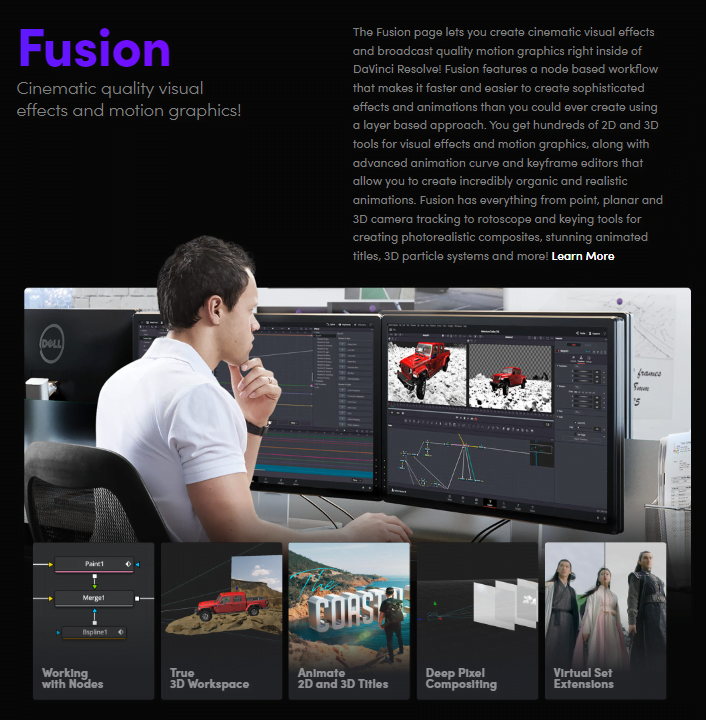
The main difference between Adobe After Effects and Fusion is that After Effects is layer-based, while Fusion is node-based. At the very beginning, I didn’t enjoy the node-based workflow, but when I started learning it, I began to enjoy it. This workflow takes your work to the next level, and I won’t return to the layer-based workflow again.
Fairlight
Fairlight is the emotion I felt when I started my video editing journey. I honestly wanted dedicated software for sound design as a video editor. Yeah, many advanced DAWs (Digital Audio Workstations) are on the market. But you must switch software and learn that DAW (Digital Audio Workstations). And the main thing is that you can’t get a preview screen in your DAW (Digital Audio Workstations) to see which clips you want to sound design.

But thanks to Blackmagic, they resolved the problem. They made a built-in DAW in DaVinci. It has everything that a professional DAW has. The main thing is a preview window to see your selected clip. So, based on that preview, you can sound design your projects. I love this.
A Professional Depth Inside of a Gentle Learning Curve
Sure, it all sounds very dandy, but aren’t you just a little bit (too) scared of Resolve? It’s a fair concern. As a bit of an aside, I know that Resolve has this reputation for pro work, so trying can be intimidating.
Except, and here’s the catch: The masterminds at Blackmagic Design behind Resolve have made it approachable. The “Cut” page interface for quick edits is clean, intuitive, and user-friendly. It is the equivalent of getting into the shallow side to test out your swimming before plunging headfirst to swim some laps.
And believe me, the deep end is where it gets juicy.
Customizable and Scalable
One thing that often gets overlooked is how customizable and scalable Resolve is. Whether you’re editing a quick YouTube video or a full-length feature film, Resolve can handle it. The software scales with your needs, from simple timeline edits to complex, multi-layered compositions.
Plus, the hardware acceleration features mean it can leverage your system’s full potential, whether you’re on a high-end workstation or a more modest setup.
It’s like having a sports car that can adapt to any road conditions, always giving you the best performance.
A Community of Creatives
And lest we forget about the community part, DaVinci Resolve has a user-friendly and rapidly expanding community. There is a wealth of resources online, be it tutorials, tips, or maybe you need to get your creative gears going! They also include lots of Training resources on their official website.
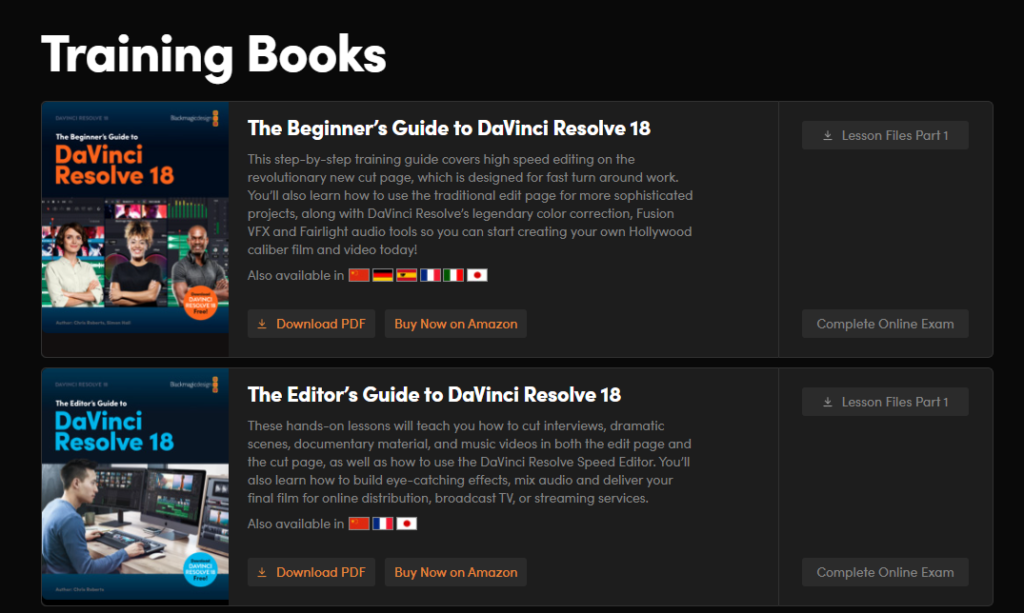
It is like being in a club of creatives who share your love and passion for storytelling and visual creation. Who wants to learn without a support team by their side?
Magic of Nodes – Free Your Imagination!
Let’s talk nodes. If the whole mention of “nodes” scares you away, do not fret. They’re not as bad and awful-sounding as they seem. Once you get the hang of them, living without them seems strange.

Nodes in DaVinci Resolve are a great way to apply effects and color corrections to your footage, but they can easily get out of control. And the best part is, you’re like a wizard with their spellbook from where all those nodes are spells, allowing you to combine them in such a magical feeling.
Looking to add an effect to a specific part of your image? It’s done. Create a stack of adjustments. It’s easy. You can go on and on with countless ideas; your imagination is the only limit.
Hardware Flexibility Equals the Freedom of Choice
And lastly, let’s discuss hardware flexibility. DaVinci Resolve offers a surprising amount of flexibility, not forcing you to use an entire ecosystem like some software.
Resolve uses Metal and CUDA, which can run on Macs now (you will need two GPUs to use Resolve) and Windows/Linux. Moreover, it backs everything from GPUs to audio consoles so you can create the arrangement that best suits your workflow. You are not locked in; you can always migrate (most of the time) and learn new software. This resembles the Choose Your Own Adventure experience of having no strings attached.
F&Q’s
WHY… The Reason To Shift to DaVinci Resolve for Video Editing???
Existing software that I wanted to replace because it was constantly bugging the hell out of me – performance and constant crashes with Premiere Pro. Giving a stable and more efficient platform via DaVinci Resolve helps prevent the constant troubleshooting needed on other workstations, so you get your creative workflow running well.
Can DaVinci Resolve Be Used by Beginners?
True, the software is supposed to be beginner-friendly while catering to professionals. Its interface for the “Cut” page is seamless, making it an ideal place for beginners.
How does DaVinci Resolve compare costs with other editor software?
DaVinci Resolve: Free version with all the most important features; Studio – $295. Unlike the subscription model (where regular payments are taken), this buys it once, and you keep it forever. Some Blackmagic cameras even come with DaVinci Resolve Studio for free.
So, then… what does the user interface of DaVinci Resolve offer?
The DaVinci Resolve interface is divided into seven spaces, like the Seven Dwarfs Mining Tunnel (Media, Cut, Edit, Fusion (?) Color (?Property?), Fairlight, and Deliver), each dedicated to a specific aspect of the editing process. The organization helps users stay focused and productive with tools designed for every workflow stage.
Does this DaVinci Resolve color grading compare with other software?
Strengths: DaVinci Resolve has a strong name within the sector due to its remarkable color grading equipment, which is smooth to examine and powerful. It allows one to fulfill creative impulses easily—even the color grading process is not a pain in Resolve; it’s quite enjoyable.
AMAZING “Magic of Nodes” in DaVinci Resolve?
Encased in a node-based design, DaVinci Resolve lets users apply effects and color corrections as they like. It can feel very intimidating initially, but it is the most incredibly liberating system I have come across once you get a grip on how to work within its bounds, which feels like being able to cast spells for us nerds.
Can DaVinci Resolve be used for multi-user collaboration?
DaVinci Resolve—Cloud-based collaboration: Cloud-based collaboration tools allow multiple project members to work together on the same edit from different locations. These are definitely welcomed features for remote work or large-scale work.
What is Fusion, and How Does It Improve Video Editing in DaVinci Resolve
Fusion is an integrated feature inside DaVinci Resolve that offers advanced visual effects and motion graphics capabilities equivalent to Adobe After Effects. It is built on a node-based architecture; unlike how layers work in After Effects, this system allows for advanced creative thoughts.
What kind of hardware flexibility do we get with DaVinci Resolve?
Your hardware can be pushed nowhere faster than with DaVinci Resolve, which has always been GPU and audio console agnostic. This flexibility in your setup means you can customize it to be most efficient for your work, making it a versatile choice.
Time to Switch Best Editing Software
So, there you have it. I covered the most important features of DaVinci Resolve and why I like it. However, this program has many more features, and I will cover more details in the future.
Based on this article, try to do your own research. When you start exploring this program as a video editor, I almost guarantee you won’t go back to your past programs. If you want to focus only on the creative part or are having trouble with your editing software and also miss the advanced features of DaVinci Resolve, the choice is yours!






